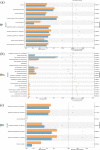Metabarcode insights into the airborne fungal diversity in the indoor and outdoor environments in archives from Yunnan, Southwestern China
- PMID: 38587763
- PMCID: PMC11153435
- DOI: 10.1007/s42770-024-01323-z
Metabarcode insights into the airborne fungal diversity in the indoor and outdoor environments in archives from Yunnan, Southwestern China
Abstract
Monitoring dynamics of airborne fungal species and controlling of harmful ones are of vital importance to conservation of cultural relics. However, the evaluation of air quality and the community structure characteristics of microorganisms, especially fungi, in the atmosphere of archives is in a stage of continuous exploration though more than 4,000 archives were constructed in China. Seventy-two air samples were collected in this study under different spatial and weather conditions from the archives of Kunming Medical University, located in the Kunming metropolitan area, Yunnan province, southwestern China. A total of 22 airborne fungal classes, 160 genera and 699 ASVs were identified, the species diversity is on the rise with the strengthening of air circulation with the outside space, and thus the intensive energy metabolism and activity were found in the spaces with window and sunny weather, except for the higher lipid synthesis of indoor samples than that of outdoor ones. Furthermore, there were significant differences in fungal community composition and abundance between sunny and rainy weathers. A considerable number of species have been identified as indicator in various environmental and weather conditions of the archives, and temperature and humidity were thought to have significant correlations with the abundance of these species. Meanwhile, Cladosporium and Alternaria were the dominant genera here, which may pose a threat to the health of archive professionals. Therefore, monitoring and controlling the growth of these fungal species is crucial for both conservation of paper records and health of archive professionals.
Keywords: Air pollution; Archive warehouse; Fungal biome; Microbiome; Relative humidity control.
© 2024. The Author(s) under exclusive licence to Sociedade Brasileira de Microbiologia.
Conflict of interest statement
On behalf of all authors, the corresponding author states that there is no conflict of interest.
Figures








References
-
- Cabral JP. Can we use indoor fungi as bioindicators of indoor air quality? Historical perspectives and open questions. Sci Total Environ. 2010;408:4285–4295. - PubMed
-
- Cappitelli F, Pasquariello G, Tarsitani G, Sorlini C. Scripta manent? Assessing microbial risk to paper heritage. Trends Microbiol. 2010;18:538–542. - PubMed
-
- Tang H, Jiang J, Fan WQ, Wang C. Investigation of air microorganism contamination in museum storeroom. Occup Health. 2015;31:2088–2092.
-
- Guiamet P, Borrego S, Lavin P, Perdomo I, de Saravia SG. Biofouling and biodeterioration in materials stored at the historical archive of the Museum of La Plata, Argentine and at the National Archive of the Republic of Cuba. Colloids Surf B. 2011;85:229–234. - PubMed
MeSH terms
Grants and funding
LinkOut - more resources
Full Text Sources
Medical

